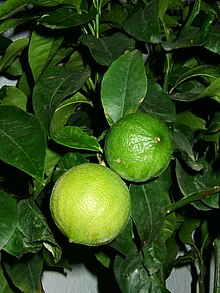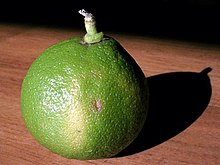Bergamot (citrus fruits)
As bergamot ( Citrus × limon , Syn. : Citrus bergamia ) refers to a group selected from the genus of Citrus Plants ( Citrus ), as hybrids from Sweet lime ( Citrus limetta ) and bitter orange ( Citrus x aurantium ) or citron ( Citrus medica ) and bitter orange. The plant was first described in the middle of the 17th century. The fruit is not used as a fruit, but is grown mainly for the essential oils contained in the bergamot peel. Bergamot oil , also known as green gold , plays a role primarily in the perfume industry, but is also used to flavor teas ( Earl Gray ).
In addition to the citrus fruits, there is also a much older group of pears of the same name , after which the citrus fruits were named because of their similar shape.
Etymology and Scientific Names
The Italian word bergamotta originally only referred to one type of pear that was imported from Turkey. The name is said to go back to the Ottoman-Turkish beg armudı (today's Turkish : bey armudu ), which means “ lord's pear ” or “prince's pear”, although the Italian name could also be influenced by the city name Bergama for Pergamon . It was not until the late 17th century that the name of the pear variety was also transferred to this citrus fruit.
The scientific name was first established by Risso and Poiteau , who named this plant species Citrus bergamia . Swingle has already speculated about the relationship between bergamot and bitter orange: the bergamot could be a mutation of the bitter orange or a hybrid with another, unknown species. Only genetic studies showed that the bergamot can be traced back to a cross between bitter orange and citron . This means that it has the same parent species as the lemon , which poses a problem for scientific naming: hybrids of the same parents should be given the same name and that of the lemon is the older in this case. The correct name for bergamot is Citrus × limon , and the addition Citrus × limon Bergamot group can be used to distinguish it from lemon .
description
The bergamot varieties reach heights of about 4 meters and have irregular branch growth, whereby the branches are rarely occupied by thorns. In contrast to lemon , the bark of the branches and the leaves are not reddish in color when they shoot. The evergreen leaves are divided into a petiole and a leaf blade. Usually the petiole is strikingly winged. The leaf blade is dark green, elongated and smooth.
The flowering time is concentrated in a certain period in spring, and the bergamot does not bear fruit throughout the year. The flowers are pure white. The fruit is round to slightly pear-shaped, often slightly ribbed and has a small protuberance at the end, to which the stylus often sticks until it is ripe. It weighs 100 to 200 grams and is lemon yellow when harvested, which takes place late from November to March. However, some selections also produce heavier fruits. The fruits are five to seven centimeters in diameter . The outer peel is smooth to slightly roughened and sticks firmly to the fruit. The greenish flesh is divided into numerous segments, it has a very sour and slightly bitter taste. The fruits form only a few, sometimes no seeds at all, which usually only contain an embryo with white or light green cotyledons.
There are three varieties: 'Castagnaro', 'Femminello' and 'Fantastico'. Castagnaro is the oldest variety that alternates between very productive and non-productive years. 'Fantastico' produces a lot of essential oil, but the 'Femminello' essential oil is considered to be of the highest quality.
Cultivation

90 percent of world production of bergamot is grown along a narrow, approximately 100-kilometer-long coastal strip between the Ionian and Tyrrhenian Seas in Calabria , from Villa San Giovanni to Gioiosa Ionica . The region in the south of Italy is characterized by extreme weather conditions in the form of long-lasting hot summers, relatively much rain in spring and mild winters.
Another traditional cultivation area is the Ionian island of Kefalonia , until the first half of the 20th century there was also an important cultivation on the neighboring island of Zakynthos (Zante).
Bergamots are also grown to a small extent outside of these regions, but the bergamot oil obtained from these fruits is of poor quality. Other growing areas include Argentina, Brazil, Mali, Guinea, Cameroon and the Ivory Coast. Individual plants can be planted for ornamental purposes in any ever-warm area.
Before 1750 there was no evidence of large-scale commercial cultivation of bergamot. However, since bergamot oil was already being processed in the perfume industry at the time, it can be assumed that it was bought up in small quantities by individual farmers. The first known large-scale cultivation took place around 1750, when the Italian Cavalieri Nicola Parisi planted the first bergamot plantation. By 1850, around 1250 hectares were already planted with bergamot trees in Calabria.
In the 19th century, significant profit margins were made less by the farmers who grew the bergamot, but more by the predominantly British middlemen for bergamot oil. This changed around the middle of the 20th century. In the 1960s, a farmer could assume that he would earn an income of EUR 50,000 per hectare of cultivated land (2014 equivalent). In the 1970s it was suspected - as it turned out to be wrong - that bergamot oil was carcinogenic, which is why the cosmetics industry turned to synthetic products. Since tourism was booming on the Calabrian coast at the same time, large parts of the cultivated area were converted into building land. Further problems arose when inferior bergamot oil mixed with other essential oils came on the market in Europe.
Since 2007, the Consorzio di Tutela del Bergamotto has been monitoring the quality of the bergamot oil traded in the European Union and can withdraw inferior products from the market. Since 1999, genuine Calabrian bergamot oil has also been allowed to carry the Denominazione d'Origine Protetta , or DOP for short , the Italian seal for products with a protected designation of origin, it corresponds to the French AOP and is a protected designation of origin (PDO) under EC law . The majority of bergamot growers have also formed an organization, which strengthens their negotiating position with wholesalers.
ingredients

The main components of bergamot oil are terpenes such as linalyl acetate , linalool , bergapten , dihydrocumin , nerol , limonene , bergaptol , limettin , 6 ', 7'-dihydroxybergamottin and bergamottin .
use
Use as a perfume raw material

The scent of bergamot oil is clear, fresh, lively, tangy and of great originality. It is included as a top note in practically all perfumes and is mainly used in eau de colognes and fresh, lemony eau de toilettes . However, bergamot oil is also used to perfume soaps, deodorants, toothpastes and shower gels. The harvest is used almost exclusively to obtain bergamot oil, which contains over 350 different flavors and thus surpasses many other natural fragrances in complexity. The refreshing aroma invigorates body and mind. It is obtained by squeezing the skin of the fruit. In the past, pressing was done by hand, then with self-made pressing devices made of wood, today it is done by machine. In order to obtain one liter of oil, 200 kilograms of fruit have to be pressed.
According to Gildemeister and Hoffmann's work The essential oils , bergamot oil was introduced between 1672 and 1708. In the business books of the Eau de Cologne and perfumery factory Johann Maria Farina opposite Jülichs-Platz in Cologne ( opposite Farina for short ), bergamot oil purchases can be found from 1714 onwards. However, there are indications that Johann Maria Farina , who has lived in Cologne since 1706, had arrived earlier developed fragrance water based on bergamot oil. In a letter to his brother from 1708, he describes a perfume that captures the scent of an Italian spring morning, the smell of mountain daffodils and that of a citrus blossom after the rain. Eau de Cologne, of which bergamot oil is an essential component, developed into a great commercial success in the following decades, which was soon sold from Cologne throughout Europe. Among its users were Louis XV. , Napoleon Bonaparte and Wolfgang Amadeus Mozart . Voltaire called it a scented water that inspires the mind and Johann Wolfgang von Goethe kept handkerchiefs soaked in eau de Cologne near his desk. Beau Nash and Beau Brummel made it the dominant men's fragrance in Great Britain in the late 18th and early 19th centuries.
Eau de Cologne was comparatively cheap compared to perfumes. It was used in large quantities by wealthy people, but it was inexpensive enough to be used in moderation by middle-class people as well. Hairdressers and pharmacists alike had it in their offer. Originally it was almost exclusively worn by men, in Great Britain it only became established as a fragrance for both sexes from 1830. Historian Ruth Goodman calls the scent of bergamot oil the dominant scent of the Victorian Age. Pure bergamot oil could be bought comparatively cheaply and it was usually found together with lemon oil even in the households of the better-off families of the working class. Since the oil was easily mixed with other fats, it was also easy to use in homemade cosmetics. It was not until 1880 that the pure fragrance of bergamot gradually went out of fashion, when the oil continued to be processed as a perfume raw material. In the high-priced segment, complexly combined perfumes are becoming increasingly popular , while lavender oil became popular in the mass market .
Extraction of bergamot oil
Johann Maria Farina first bought bergamot oil that had been pressed out of the peel in Calabria. However, the quality of the essential oil obtained varied greatly, although Farina sent the producers precise manufacturing instructions. Farina also found that the essential oil reacted with the copper vessels in which it was transported. His attempt to buy only bergamot oil, which was kept in glass vials or ceramic vessels sealed with beeswax and linen, did not lead to any significant improvement either. Farina took over the extraction of the essential oil herself for a while, so that bergamot oil was extracted in Cologne for a while.
The peel of a bergamot is so full of essential oils that even a slight pressure is enough for this oil to escape. An old traditional method is to press sponges against the fruit and then squeeze these sponges out over catch basins. The garden historian Helena Attlee notes that oil obtained in this way is considered by some perfumers to be of the highest quality.
In 1844 Nicola Barilla developed the macchina Calabrese , which simplified the labor-intensive process of oil extraction. Bergamots were placed in a metal bowl with small metal tips holding the fruit. A second, sharp-bladed bowl was slowly lowered onto these fruits. Turning the crank caused the top shell to move and the combination of pressure and rotation of the top shell caused oil and water to run out of the bergamot shells and pool in a basin below. The crushed bergamot shells were then filtered through wool filter bags that were hung up. Basins underneath caught the remaining oil.
Use as a food
Bergamot oil is used to flavor Earl Gray and Lady Gray tea ; it is also found in a special kind of Turkish Akide sweets and in French sweets from Nancy ; it is also used to flavor pipe and snuff tobacco.
Jam made from bergamot fruits is a specialty : it has a sour taste, slightly bitter with an unmistakable aroma . Products such as figs and hot peppers pickled in bergamot syrup are also produced in Calabria.
The leftovers from the bergamot harvest are usually used in a second processing stage to make juices and schnapps.
Other uses
The essential bergamot oil obtained from the peel of the bergamot is diluted with a much larger amount of olive oil and used as a tanning accelerator. The substances furocoumarins contained in bergamot, however, also have a toxic effect in combination with sunlight, which is why this type of application is not recommended in order to prevent damage to the skin.
There is an ancient craft in Calabria in which dried bergamot fruit bodies are used as bags for snuff .
In Calabria, bergamot oil diluted with almond oil was also used to treat scabies in the 19th century .
In addition, bergamot juice has found its way into haute cuisine for some time as a flavoring substance, comparable to lime juice .
literature
- Helena Attlee: The Land Where Lemons Grow: The Story of Italy and its Citrus Fruit. Penguin Books, London 2015, ISBN 978-0141-96786-8 .
- Giovanni Dugo, Ivana Bonaccorsi (eds.): Citrus bergamia. Bergamot and Its Derivatives. Production, Processing, Food, and Medicinal Values (R. Hardman (series ed.): Medicinal and Aromatic Plants - Industrial Profiles , Volume 51), CRC Press - Taylor & Francis, Boca Raton u. a. 2014, ISBN 978-1-4398-6227-8 .
- Walter Reuther, Herbert John Webber, Leon Dexter Batchelor (Eds.): The Citrus Industry. 1967-1989. University of California. The Citrus Industry, Volumes 1, 2 & 5 , online file.
Individual evidence
- ↑ Federici, CT, Roose, ML and Scora, RW (2000). RFLP ANALYSIS OF THE ORIGIN OF CITRUS BERGAMIA, CITRUS JAMBHIRI, AND CITRUS LIMONIA. Acta Hortic. 535: 55-64. doi : 10.17660 / ActaHortic.2000.535.6
- ↑ E. Nicolosi et al .: Citrus phylogeny and genetic origin of important species as investigated by molecular markers. In: Theoretical and Applied Genetics , Volume 100, Issue 8, 2004, pp. 1155-1166.
- ↑ a b Helena Attlee: The Land Where Lemons Grow . P. 155.
- ↑ a b The green gold of Calabria. The secret of Earl Gray and Eau de Cologne. Documentation, 2007, 45 min., Script and direction: Stephan Düfel, production: SR , first broadcast: February 9, 2008.
- ↑ Helmut Genaust: Etymological dictionary of botanical plant names. 3rd, completely revised and expanded edition. Nikol, Hamburg 2005, ISBN 3-937872-16-7 (reprint from 1996).
- ^ H. Marzell: Dictionary of German plant names. S. Hirzel, Leipzig, 1943.
- ↑ E. Nicolosi et al .: Citrus phylogeny and genetic origin of important species as investigated by molecular markers. In: Theoretical and Applied Genetics , Volume 100, Issue 8, 2004, pp. 1155-1166.
- ^ DJ Mabberley: A classification for edible Citrus (Rutaceae). In: Telopea , Volume 7, Issue 2, 1997, pp. 167-172. (PDF; 62 kB) ( Memento from October 4, 2009 in the Internet Archive )
- ↑ Helena Attlee: The Land Where Lemons Grow . P. 158.
- ↑ a b c d Helena Attlee: The Land Where Lemons Grow . P. 168.
- ↑ Helena Attlee: The Land Where Lemons Grow . P. 157.
- ^ Giovanni Dugo, Ivana Bonaccorsi: Citrus bergamia: Bergamot and its Derivatives p. 186
- ^ Ernst Friedrich: General and special economic geography, Volume 2 - page 56, 1926. (There is a reproduction from 2014, ISBN 978-1-294-91067-1 )
- ↑ a b Helena Attlee: The Land Where Lemons Grow . P. 160.
- ↑ Helena Attlee: The Land Where Lemons Grow . P. 165.
- ↑ Helena Attlee: The Land Where Lemons Grow . P. 169.
- ↑ PETER P. FU, QINGSU XIA, YUEWEI ZHAO, SHUGUANG WANG, HONGTAO YU, HSIU-MEI CHIANG: Phototoxicity of Herbal Plants and Herbal Products . In: Journal of Environmental Science and Health, Part C: Environmental Carcinogenesis and Ecotoxicology Reviews . 31, No. 3, 2013, pp. 213-255. doi : 10.1080 / 10590501.2013.824206 .
- ↑ BERGAMOT OIL: Uses, Side Effects, Interactions and Warnings . Accessed April 2014.
- ↑ Helena Attlee: The Land Where Lemons Grow . P. 167.
- ↑ Helena Attlee: The Land Where Lemons Grow . P. 159.
- ^ Ruth Goodman: How to be a Victorian. Penguin Books, London 2013, ISBN 978-0-241-95834-6 . P. 131.
- ^ A b c Ruth Goodman: How to be a Victorian. Penguin Books, London 2013, ISBN 978-0-241-95834-6 . P. 132.
- ^ Ruth Goodman: How to be a Victorian. Penguin Books, London 2013, ISBN 978-0-241-95834-6 . P. 133.
- ^ Ruth Goodman: How to be a Victorian. Penguin Books, London 2013, ISBN 978-0-241-95834-6 . P. 134.
- ↑ a b c Helena Attlee: The Land Where Lemons Grow . P. 163.
- ↑ Helena Attlee: The Land Where Lemons Grow . P. 171.
- ↑ Helena Attlee: The Land Where Lemons Grow . P. 166.




